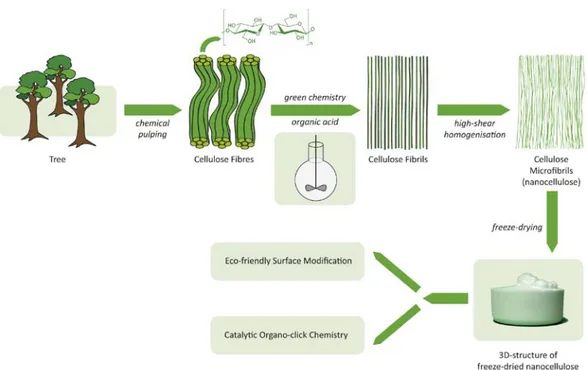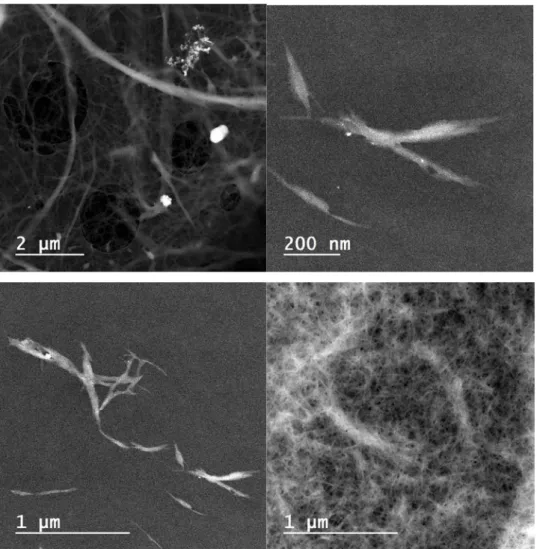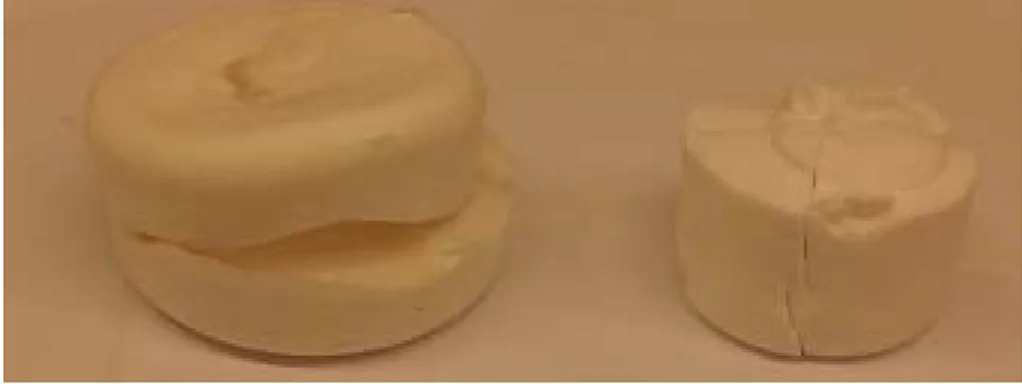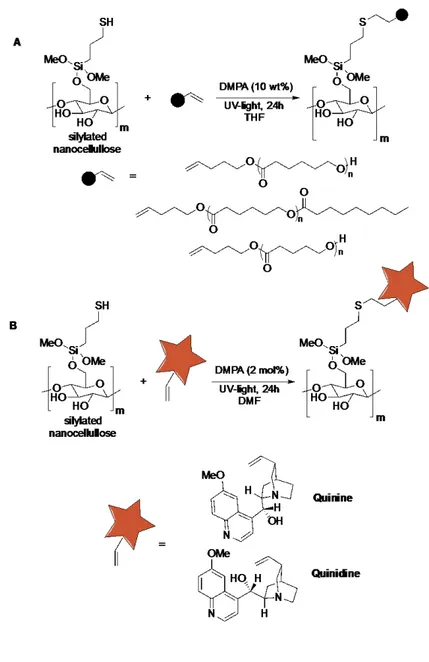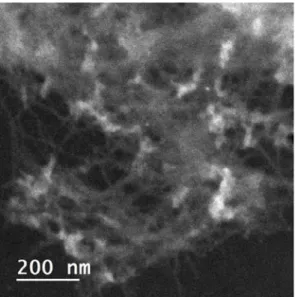1
Eco-friendly design for scalable direct fabrication of nanocellulose
Samson Afewerki,1 Rana Alimohammadzadeh,1 Sinke H. Osong,2 Cheuk-Wai Tai,3 Per Engstrand,2 & Armando Córdova1
ABSTRACT
Cellulose1 is the most abundant sustainable material on earth.2,3 This biopolymer has excellent mechanical material properties (e.g. high strength, high modulus, low density, etc.) and is renewable, eco-friendly, biodegradable, non-toxic and reusable. Due to the significant emergence of forest nanotechnology, the growing interest of sustainability and the more restriction of petroleum-derived materials, there is an utmost need for development of new production methods and cost-efficient solutions in order to engineer new cellulosic nanomaterials. Scientific research on and the use of wood-derived nanocellulose have developed enormously over the past decade.4-8 The material is widely utilized by the forest products industry in research projects and pilot-scale activities, and there is now a strong drive to commercialise nanocellulose for future applications (e.g. packaging, cosmetics, nanocomposites, pharmaceuticals, hygiene products, foams, paper and paperboard). Thus, the commercialization of nanocellulose is forthcoming with a projected GDP of 600 billion USD worldwide by 2020.9,10 However, low moisture resistance, high energy use in production as well as need for sustainable and versatile methods for surface engineering have been described as obstacles for this future development. In this context, although notable success has been made for the production of nanocelluloses, there is still a need for development of environmentally benign approaches, which reduce the overall energy consumption, avoid the use of radical initiators and chlorine-based oxidants. To address the above challenges, we disclose a novel eco-friendly strategy for the scalable direct fabrication and versatile functionalization of nanocelluloses from wood pulp using metal-free catalysis and UV-light (Figure 1). Here the organic acid mediated
1 Department of Natural Sciences, Mid Sweden University Holmgatan 10, 851 70 Sundsvall Sweden, 2Department of Chemical Engineering, Mid Sweden University, Holmgatan 10, 851 70 Sundsvall Sweden, 3Department of Materials and Environmental Chemistry, The Arrhenius Laboratory, Stockholm University, 106 91 Stockholm Sweden, University, 106 91 Stockholm, Sweden.
2
nanocellulose production is high yielding and requires low energy in-put and the catalytic direct surface engineering is modular and applicable to different types of nanocellulosic materials.
Introduction
There are two types of wood-based nanocelluloses11,12 derived from wood, the nanofibrillated cellulose (NFC) and the nanocrystalline cellulose (NCC). The NFC is spaghetti-like in structure, long and flexible, less than 100 nm in width and several microns in length, have both crystalline and amorphous regions intact. Potential applications of NFC and NCC include; functional and barrier coatings in paper and paperboard, strength additives, films, emulsion, foams, optical devices, adhesive, composites, biomedical engineering, cement, packaging, fillers, non-woven, textile and separation membranes. Therefore different chemical methods have been developed for their production. For example, NCC is made by hydrolysis using inorganic acids (e.g. sulphuric acid and phosphoric acids) and renders highly crystalline and rigid nanoparticles.13-15 Since the amorphous region of the fibril is degraded the yield is low (30-50 % yield). With respect to NFC fabrication, examples of routes that have been investigated are: mechanical agitation (high-energy),11,12,16,17 chemical-mechanical methods (carboxymethylation route (high energy, carboxymethylation),18,19 2,2,6,6,-tetramethylpiperidine-1-oxyl (TEMPO)-NaClO-oxidation-homogenization (low-energy, radical mediator, chlorine-based oxidant),7,20 enzymatic hydrolysis-homogenization
(low energy, biocide added due to enzyme stability).21 Life cycle analyses have shown that all these fabrication process exhibit prominent environmental advantages over other nanomaterials like carbon nanotubes.22,23 Among them the enzymatic-pretratment route
and mechanical agitation exhibits lowest environmental impact. However, the stability of enzymes and high energy in production by the mechanical are important cost-factors. With respect to the chemical treatment methods, it was shown that the (TEMPO)-NaClO-oxidation-homogenization route had a lower impact as compared to the carboxymethylation route. However, the presence of active radical initiator and non-selective chlorine-based oxidants is a disadvantage in large-scale production. Moreover, it was shown that sonication processes have more environmental impact as compared to
3
homogenization routes. Once the nanocellulose materials are produced they exhibit several important properties. However, they are very moisture sensitive and the surface is hard to modify under environmentally benign conditions. In fact, the direct modification of heterogeneous cellulose is very challenging and therefore it is commonly dissolved prior to modification.24 Here Cordova-Hafren disclosed in 2005 that heterogeneous lignocelluloses could be directly functionalized and hydrophobized using organocatalysis.25,26 These approaches have also recently been utilized for the direct surface functionalization of nanocellulose. “Click chemistry” a concept introduced by Scharpless and co-workers have also been utilized for the surface-functionalization to a cellulose surface. However, a functionalized group has to be introduced prior to the application of a “click” chemistry reaction. Here the application of organocatalysis brings a direct route to achieve this under environmentally benign conditions.
Figure 1. The direct formic acid mediated route to NFC and “organoclick” functionalization of
4
Results and discussion
Based on our research in eco-friendly chemistry and the above challenges in nanocellulose production, we envisioned a new process for the fabrication of nanocellulose using organic acid mediated hydrolysis of wood-pulp (Figure 1). Similar to the enzyme-pre-treatment route it would have the advantage of being a mild but it would also be more robust and the organic acid could be readily recycled. However, today organic acids such as formic acid are employed for complete depolymerization of wood biopolymers to monomeric units. Thus, the current literature supported that a potential NFC fabrication process may be hard to control and result in low yields. Moreover, we wanted to invent a modular strategy for the surface modification of this NFC using first organic catalysis followed by “click” chemistry. This “organoclick” chemistry functionalization of the NFC should be an important tool to add for the expansion and use of nanocelluloses in the above-mentioned applications. We began to investigate the organic acid mediated NFC fabrication.
5
Figure 2. TEM pictures of different samples: Top left is sulphite softwood dissolving pulp. Top right is
formic acid fabricated NFC. Bottom left is formic acid fabricated NFC. Bottom right is NFC derived from the TEMPO-NaClO oxidation- homogenization route.
Here sulphite softwood dissolving pulp was pre-treated with formic acid at various temperatures followed by homogenization. To our delight, we discovered that we could produce NFC in quantitative yield at relatively low temperatures (70-90 °C). The transmission electron microscopy (TEM) studies of the fine white powder revealed that the fibers had been individualized and the diameters of the fibers were in the nanoscale size (<20 nm, Figure 2). We also found out that the formic acid derived NFC could aggregate upon standing due to lack of charge. In comparison, the NFC derived by the TEMPO-NaClO-oxidation-homogenization of sulphite softwood dissolving pulp did not aggregate due to the charges introduced on the cellulose surface. Therefore, the formic acid derived NFC was made to a foam material (Figure 3a) after its fabrication with a specific surface area (SBET) of 6.7 m2g-1 and pore size (PBJH) of 91.8 nm (Figure 3a). In
6
comparison, the foam made from the TEMPO-NaClO-oxidation-homogenization route had a SBET of 19.3 m2g-1 and PBJH of 110 nm. We also developed a route for NFC
production based on TEMPO-aerobic oxidation-formic acid treatment in order to introduce charge and avoid the use of NaClO as the terminal oxidant.
Figure 3a. Foam material from freeze-dried NFC: The left foam material is NFC from TEMPO method.
The right foam material is NFC from formic acid method.
Fourier transform infrared (IR) spectroscopic analysis of the organic acid fabricated NFC revealed that the surface had been esterified by a small amount of formic acid. This may be one of the reasons that the nanocellulose could be generated under such mild conditions. However, the NFC was not hydrophobic. The formic acid method was also performed on a 10g scale and the corresponding NFC was fabricated in quantitative yield. The remaining formic acid was recycled and used again. Being satisfied with the development of this mild and scalable NFC production route, we embarked on the organocatalytic surface modification of the NFC foam. The silane bond is robust and more stable to basic conditions than the ester bond. There are also a lot of commercial silanes that could be attached by this metal-free route. A screen of different acids for their ability to catalyse the sillylation of octanol revealed that (S)-tartaric acid and maleic acid were excellent catalysts for this transformation. Thus, a variety of different silanes (1a-1d) were investigated for the direct catalytic silylation of NFC using (S)-tartaric acid as the catalyst (Scheme 1). Elemental analysis revealed that all had been modified with a small degree of substitution. Even at these low degrees of substitution the direct catalytic attachment of hydrophobic silanes to the nanocellulosic materials made them water repellent (Figure 3b). The metal-free catalysis was also conducted on TEMPO-NaClO-homogenization derived NFC and it became hydrophobic as well.
7
Performing the same procedure on filter paper enabled us to measure the contact angle, which ranged between 96-130 degrees for attachment of silanes (1a-1d). The measurement of the pore size on the formic acid derived-NFC foam substituted with the C16 silane 1d revealed that the specific surface area (SBET) and pore size (PBJH) was 7.0
m2g-1 and 77.7 nm, respectively. The pore volume was also similar before and after the direct hydrophobization (VBJH 0.015 vs 0.014 cm3g-1). Hence, the NFC foams stayed
intact after the direct catalytic silylation had been performed. The attachment of aminopropyl (AmP) silane 1d is also notable since it demonstrated that organic amines could be attached by this way, which are useful for catalytic applications and binding of metal and enzyme catalysts.8 In fact, this was also demonstrated for the AmP-NCF by binding Pd(II) salts to form AmP-NCF-Pd(II)-complexes. Next, reduction with NaBH4
converted the Pd(II) salt to Pd nanoparticles and a sustainable AmP-NCF-Pd(0)-nanocatalyst was formed. To our delight, it was found to be an efficient catalyst for C-C bond-forming reactions (See SI).
Scheme 1. Direct organocatalytic surface modification of heterogeneous NFC with silanes 1.
8
Having established a versatile organocatalytic direct nanocellulose modification method, we chose to investigate the “organoclick” strategy for functionalization of NFC using (S)-tartaric acid and UV light. Therefore formic acid generated NFC was first catalytically modified with thiapropylsilane (TPSi) and allylsilane groups using (S)-tartaric acid as the catalyst. Next, the thiol-ene click reactions were performed on the olefin- and thiol-functionalized NFCs, respectively, using a UV-lamp and a metal-free initiator (Tables 1, Scheme 2). The thiol end-group functionalized polyesters were chosen as the initial substrates for the allyl-modified NFC since the polyester groups could be readily detected by FT-IR (Table 1). Consequently the reaction was performed and after significant soxhlet extractions it was determined that the polyesters (poly(ε-caprolactone) (PCL) and poly(δ-valerolactone) (PVL)) had been attached by FT-IR analysis. We also attached n-octane-1-thiol by the click reaction. This reaction is much faster as compared to when the polyesters were used as the substrates. This was carefully confirmed by monitoring the homogeneous click reactions between n-octane-1-thiol and thiol end-group functionalized PCL with trimethoxyallylsilane using 1H
NMR analysis.
9
The thiol-ene click reactions between TPSi-modified-NCF and the olefin end-group functionalize polyesters (PCL and PVL), which had been produced by chemoselective enzyme- or (S)-tartaric acid-catalyzed polymerizations, were also investigated (Scheme 2a). The reactions worked smoothly generating polyester (PCL and PVL) functionalized NFCs. An important factor in the engineering of the cellulose surface is the attachment of fluorescent and UV-active groups with applications in sensors and biological applications (e.g. cell uptake and viability). However, the introduction of a functional group on the NFC surface is not eco-friendly and even hazardous solvents are employed (pyridine). Another important potential application for NFC is to use it as a sustainable supporting material for organic molecules that serve as ligand or catalysts in homogeneous catalysis. Thus, the direct attachment of catalysts on the NFC would make the cellulose surface catalytically active and open up for several applications including diagnostics and heterogeneous catalysts. To demonstrate the potential for this selective chemistry, we decided to investigate the attachment of the pharmaceutical agents quinidine and quinine to the NFC (Scheme 2b). These natural products isolated from the bark of the cinchona tree exhibit important biological activities (e.g. anti-malaria, anti-arrhythmic heart, lupus and arthritis). They are also used as fluorescent markers, organocatalysts and organic chiral ligands for metal-catalysts. Here they mediate several important asymmetric reactions (e.g. conjugate additions, oxidations, kinetic resolutions and Sharpless asymmetric dihydroxylation) used in selective organic synthesis. Consequently, formic acid-fabrication of NFC was followed by its “organoclick” direct functionalization with cinchona alkaloids. Here the (S)-tartaric acid direct modification to generate TPSi-modified NFC was followed by “click” reaction with quinine under UV-light and a metal-free photo catalyst. The same procedure was performed with quinine. After extensive soxhlet extraction, we investigated the fluorescent activity of the NFC, TPSi-modified NFC and the NFCs treated with a cinchona alkaloid. Only the quinidine-TPSi-NFC and quinine-TPSi-NFC were fluorescent whereas the TPSi-NFC and NFC were not (Figure 4). The above described “organoclick” chemistry strategy was also successful on TEMPO-NaClO produced NFC, NCC and filter paper. Several thiol and olefin functionalize molecules were directly attached on allyl- and TPSi-modified cellulosic materials, respectively. Thus, the disclosed eco-friendly technology can be considered a broad and versatile strategy
10
for the direct surface engineering of nanocellulose and lignocellulosic materials. We also cross-linked the formic acid- and fabricated NFC-foams by first functionalized them with equal amounts of TPSi and allyl silane using (S)-tartaric acid as the catalyst. Next, the resulting TPSi-and allyl-functinoalized NFC foams were reacted under UV light to generate cross-linked hydrophobic NFC, which were analysed by elemental, TEM and gas adsorption analyses. For example, the TEM analysis showed that a fine network was formed with SBET = 7.5 m2g-1, PBJH = 69.2 nm and VBJH = 0.013 cm3g-1 for
the formic acid generated NFC (Figure 5). The cross-linking approach was also applied on TEMPO-NaClO-derived NFC. The strategy of producing TPSi-and allyl-functinoalized NFCs allows for selective attachment of different compounds with an olefin or a thia-group. This was demonstrated by the attached of both quinine and polyester with a thiol end-group to the TPSi-and allyl-functinoalized NFC as determined by elemental analysis, FT-IR and UV-spectroscopy.
11
Scheme 2.
Figure 4. Modified NFC under a UV-lamp: A: modified NFC with (3-mercaptopropyl)trimethoxysilane.
12
Figure 5. TEM image of cross-linked NFC foam material by the “organoclick” strategy.
Conclusions
In summary, we have developed a unique eco-friendly concept for the scalable fabrication and direct engineering of NFC using metal-free catalysis and UV-light. The nanocellulose production requires low energy input, is high yielding and the formic acid mediator can be recycled. It also avoids the usages of radical initiators and chlorine-based oxidants, which produces organochlorines and persistent pollutants including dioxins in industrial production. The “organoclick” engineering of the NFC was demonstrated by making it hydrophobic as well as introducing different types of functional groups (e.g. alkyl, thia, amino and olefinic groups) by using non-toxic direct organic acid-catalyzed silylation. It was also found that the AmP-NFC could bind metal salts and be converted to a AmP-NFC-Pd(0)-nanoparticle catalyst for C-C bond-forming reactions. Next, the versatility of the concept was further demonstrated by performing click-reactions on the TPSi and allyl-functionalized NFC under UV-light. Here biodegradable polyesters produced by catalytic “green” chemistry as well as natural products, which are pharmaceutical, fluorescent and catalytically active agents serving as metal-free catalysts and ligands for asymmetric synthesis, were smoothly attached to
13
the nanocellulose. The eco-friendly strategy disclosed here (Figure 1) addresses several of the obstacles and challenges in the future developments of nanocelluloses such as eco-friendly production and functionalization as well as water and moisture sensitivity. It also opens up for new applications of nanocellulose in different areas (e.g. pharmaceuticals, electrodes, sensors and as heterogeneous catalyst) with complete sustainable chemistry and materials chemistry.
References
1. Payen A., Memoire sur la composition du tissu propre des plantes et du ligneux,
Comptes Rendus, 7, 1052-1056, (1838).
2. Klemm D. et al. Nanocelluloses as innovative polymers in research and application. In: Klemm D (ed) Advances in Polymer Science (Polysaccharides II), vol 205. Springer Heidelberg, pp 49–96 (2006).
3. Iwamoto S, Nakagaito AN, Yano H & Nogi M. Optically transparent composites reinforced with plant fiber-based nanofibers. Appl Phys A 81,1109–1112 (2005).
4. Osong, H. S., Norgren, S. & Engstrand, P. Processing of wood-based microfibrillated cellulose and nanofibrillated cellulose, and applications relating to papermaking: a review. Cellulose, 23, 93-123. (2016).
5. Klemm, D. et. al. Nanocelluloses: A new family of nature-based materials. Angew.
Chem., 50, 5438. (2011).
6. Nair, S. S., Zhu, J. Y., Deng, Y. & Ragauskas, A. J. High performance green barriers based on nanocellulose, Sustainable Chemical Processes, 2, 23. (2014).
7. Isogai, A., Saito, T., Fukuzumi, H. TEMPO-oxidized cellulose nanofibers, Nanoscale,
3, 71-85 (2011).
8. Lam, E. et al. Applications of functionalized and nanoparticle-modified nanocrystalline cellulose. Trends. Biotechnol., 30, 283-290. (2012).
9. TAPPI. International Nanocellulose standards-The need and purpose of standards for nanocellulose materials; TAPPI: Norcross, Ga, June 9, 2011.
10. Crotigino, R. The economic impact of nanocellulose, Arbora Nano: Washingtong D. C. March 27-28, 2012.
11. Turbak A.F., Snyder F.W. & Sandberg K. R. Microfibrillated cellulose, a new cellulose product: properties, uses, and commercial potential. J Appl Polym Sci Appl Polym
14
12. Herrick, F.W., Casebier, R. L., Hamilton J.K. & Sandberg, K. R. Microfibrillated Cellulose: Morphology and accessibility. J Appl Polym Sci Appl Polym Symp., 37, 797– 813. (1983).
13. Marchessault, R. H., Morehead, F. F. & Walter, N. M. Liquid crystal systems from fibrillar polysaccharides, Nature, 184, 632 - 633 (1959).
14. Dong, X. M., Revol, J.-F. & Gray, D. G. Effect of microcrystallite preparation conditions on the formation of colloid crystals of cellulose. Cellulose, 5, 19–32, (1998). 15. Elazzouzi-Hafraoui, S. et. al. The shape and size distribution of crystalline nanoparticles
prepared by acid hydrolysis of native cellulose. Biomacromolecules, 9, 57–65. (2008). 16. Wuhrmann, K. et. al. Electron-microscopic investigation of cellulose fibers after
supersonic treatment. Experienta, 2, 105-107 (1946).
17. Spence, K. L. et. al. A comparative study of energy consumption and physical properties of microfibrillated cellulose produced by different processing methods.
Cellulose, 18, 1097-1111. (2011).
18. Wågberg, L. et al. The build up of polyelectrolyte multilayers of microfibrillated cellulose and cationic polyelectrolytes. Langmuir, 24, 784-795. (2008).
19. Eyholzer, C. et al. Preparation and characterization of water-redispersible nanofibrillated cellulose in powder form. Cellulose, 13, 19-30. (2010).
20. Isogai, A. Wood nanocelluloses: fundamentals and applications as new bio-based nanomaterials. J. Wood. Sci., 59, 449-459 (2013).
21. Pääkö, M. et. al. Enzymatic hydrolysis combined with mechanical shearing and high pressure homogenization for nanoscale cellulose fibrils and strong gels.
Biomacromolecules, 8, 1934-1941 (2007).
22. Li, Q. et al. Nanocellulose life cycle assessment. ACS Sustainable Chem. Eng. 1, 919-928. (2013).
23. Arvidsson, R., Nguyen, D., Svanström, M. Life cycle assessment of cellulose nanofibrils production by mechanical treatment and two different pretreatment processes. Environ. Sci. Technol. 49, 6881-6890. (2015).
24. Heinze, T. & Liebert, T. Polymer Science: A Comprehensive Reference, Vol. 10 (Eds: K. Matyjaszewski , M. Möller ), Elsevier B. V ., Amsterdam, Netherlands 83. (2012). 25. Hafrén, J. & Córdova, A. The direct organocatalytic polymerization from cellulose fibers.
Macromol. Rapid Commun. 26, 82. (2005).
26. Calmark, A.; Larsson, E. & Malmström, E. Grafting of cellulose by ring-opening polymerisation – A review. Eur. Pol. J., 48, 1646-1659. (2012).
15
Supplementary Information is available in the online version of the paper.
Acknowledgements. We gratefully acknowledge financial support from the European Union, Mid Sweden University and Swedish National Research Council. The Knut and Alice Wallenberg Foundation is acknowledged for an equipment grant for the electron microscopy facilities at Stockholm University.
Contributions S.A. and A. C. planned the organic acid nanocellulose fabrication, “organoclick” chemistry and catalysis experiments. S. A. and R.A. conducted the experiments and analyzed the nanocelluloses. S.A. and S.O prepared the NFCs. C.W.T planned and conducted the electron microscopy experiments. P. E. and S. O. designed and directed the TEMPO-NaClO fabricated NFC production. AC designed and directed the project. A. C., S.A., S.O. and P. E. wrote the paper.
Author Information Reprints and permissions information is available at …. Financial
interests: A patent has been filed. Readers are welcome to comment on the online version of the paper. Correspondence and requests for materials should be addressed to A. C. (armando.cordova@miun.se).
